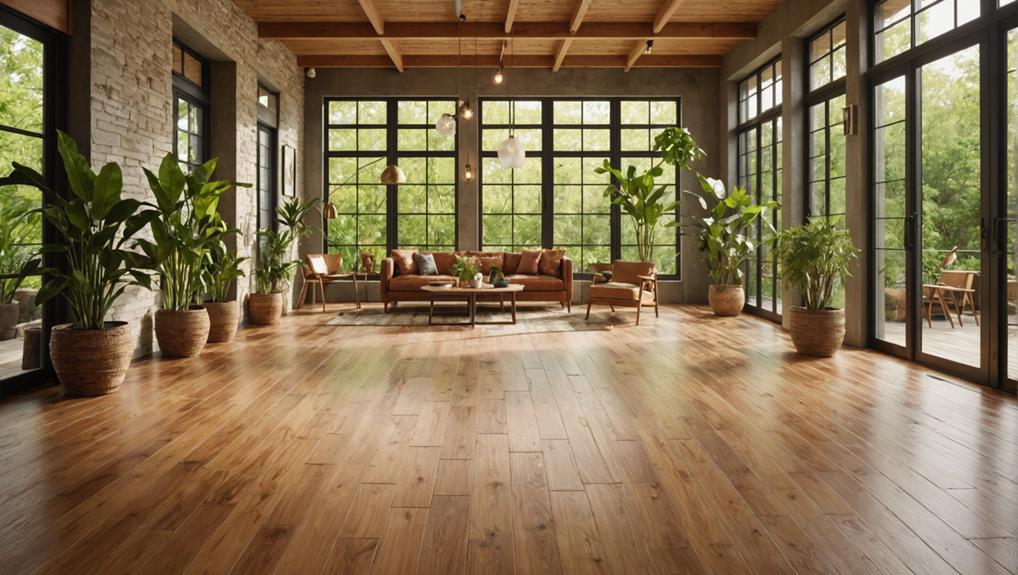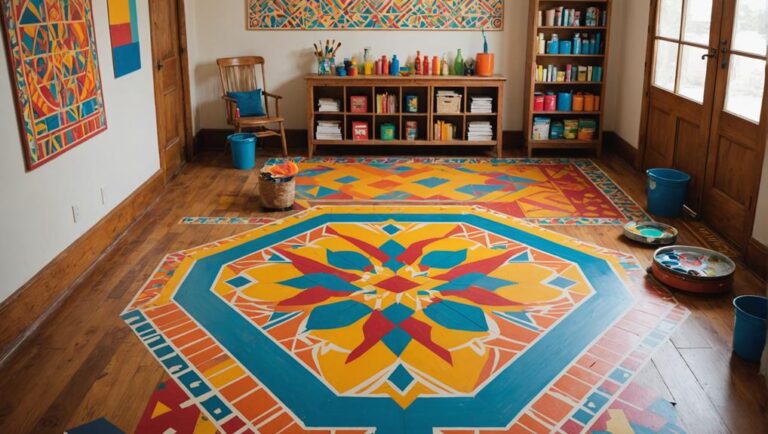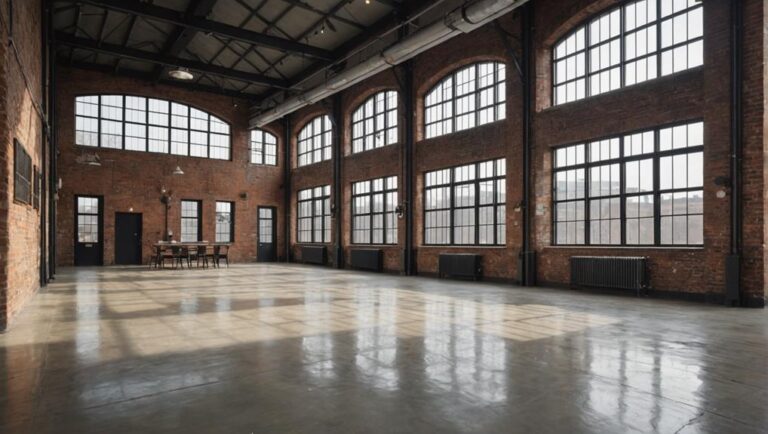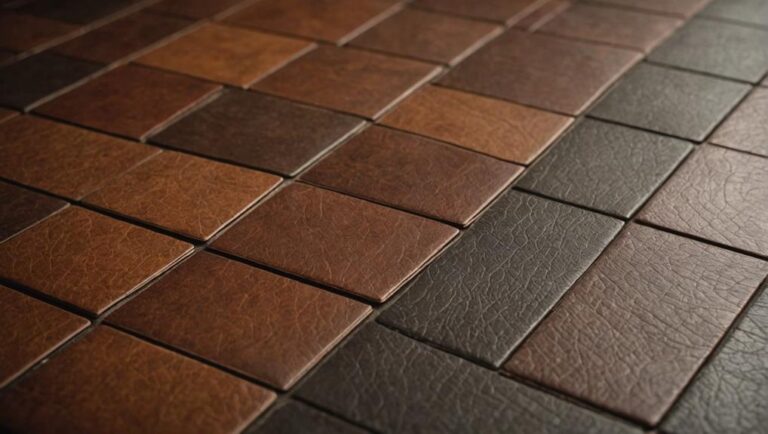When choosing eco-friendly floor finishes, consider options like organic oils, plant-based waxes, and low-VOC products. These choices not only improve the aesthetic appeal of your space but also enhance indoor air quality by greatly reducing harmful emissions. Materials like bamboo and cork provide sustainable alternatives due to their rapid renewability and gentle harvesting practices. Recycled material flooring offers exceptional durability and design versatility. These finishes promote a healthier environment for you and your family, aligning with eco-conscious values. Explore further benefits and options that will perfect your sustainable home decor.
Benefits of Eco-Friendly Finishes
When considering a new floor finish, you might want to think about the benefits of eco-friendly options. Choosing these finishes can greatly lower your home's environmental impact. Traditional floor finishes often contain harmful chemicals that can leach into the air and contribute to indoor pollution. Eco-friendly alternatives, however, are typically made from natural ingredients, which reduces the release of volatile organic compounds (VOCs) that can be harmful to both your health and the environment.
In addition to being better for the planet, eco-friendly finishes offer a variety of health benefits. These products are usually free from toxic substances, which means you won't have to worry about exposing your family to harmful chemicals. For instance, many eco-friendly finishes are water-based, making them safer to use and applying fewer hazards during installation. This can lead to improved indoor air quality, which is particularly important for those with respiratory issues or sensitivities.
Moreover, opting for eco-friendly finishes often means supporting sustainable practices. Many manufacturers prioritize renewable resources, ensuring that your choice contributes to a greener planet. By selecting these finishes, you're not just making a personal choice; you're participating in a broader movement towards sustainability.
Natural Wood Finishes
When considering natural wood finishes, you'll find various options that enhance the beauty of your floors while being environmentally friendly. Understanding the different types of finishes available and the application techniques can help you achieve the best results for your space. By choosing natural finishes, you not only protect your investment but also contribute to a healthier indoor environment.
Types of Natural Finishes
In the domain of eco-friendly flooring, selecting the right natural wood finishes can greatly impact both aesthetics and sustainability. When you're considering your options, two prominent choices stand out: organic oils and plant-based waxes.
Organic oils, like tung and linseed, not only enhance the wood's natural beauty but also penetrate deeply, providing a protective layer that's both durable and non-toxic. These oils are derived from renewable resources, ensuring your choice is environmentally friendly. They help maintain the wood's moisture balance, preventing splitting and warping while being safe for your family and pets.
On the other hand, plant-based waxes offer a different approach. They create a surface finish that's easy to apply and reapply, giving you flexibility in maintenance. Waxes can provide a warm, natural glow to your flooring, enhancing its aesthetic appeal without compromising safety.
Choosing between these finishes ultimately depends on your specific needs and preferences. Both organic oils and plant-based waxes offer sustainable, safe solutions that align with your eco-friendly values. By selecting natural finishes, you're not just investing in your home's beauty, but also in a healthier planet.
Application Techniques Explained
Applying natural wood finishes requires a thoughtful approach to guarantee the best results for your flooring. When considering application methods, you want to make certain that the surface preparation is meticulously done. This not only enhances the finish's durability but also guarantees a safe environment for your home.
Here's a quick overview of popular application methods and their benefits:
| Application Method | Key Benefits |
|---|---|
| Brush | Precise control, even coverage |
| Roller | Fast application, less mess |
| Spray | Smooth finish, minimal effort |
| Pad | Great for large areas, easy to use |
Before applying any finish, make sure to clean the surface thoroughly and sand it down to eliminate imperfections. This step is essential for achieving a smooth, long-lasting finish. Always use eco-friendly products to maintain a safe indoor environment.
Bamboo Flooring Options
When considering eco-friendly flooring, bamboo is an excellent option due to its remarkable sustainability and rapid growth. You'll want to familiarize yourself with the installation process, which can be straightforward with the right tools and techniques. Plus, understanding maintenance and care tips will help guarantee your bamboo flooring remains beautiful and durable for years to come.
Sustainability of Bamboo Flooring
Bamboo flooring's allure lies not just in its aesthetic appeal but also in its remarkable sustainability. When you choose bamboo, you're opting for a material that grows incredibly fast—about three to five years to maturity—making it a renewable resource. This rapid growth is an essential component of bamboo sustainability practices, as it minimizes the environmental impact associated with traditional hardwoods, which can take decades to regenerate.
Moreover, bamboo flooring advantages extend beyond its growth rate. Bamboo absorbs carbon dioxide and releases oxygen, contributing positively to air quality. Since it's harvested without killing the plant, it maintains the surrounding ecosystem, guaranteeing biodiversity remains intact. Additionally, many manufacturers adhere to responsible sourcing, which guarantees that the bamboo you're using is grown and harvested sustainably.
You'll also find that bamboo flooring is durable and resistant to moisture, making it a safe choice for various environments. As you consider flooring options, think about how bamboo not only beautifies your space but also aligns with your commitment to sustainability and safety for your family and the planet. Choosing bamboo is a step towards a greener future.
Installation Process Overview
Installing bamboo flooring can be a straightforward yet rewarding experience that enhances both the beauty and sustainability of your home. However, it's important to be aware of potential installation challenges. One common issue is humidity, which can affect the bamboo's expansion and contraction. Before starting, acclimate the planks in the room for at least 72 hours to allow them to adjust to the environment.
Preparation tips are vital for a successful installation. Begin by verifying your subfloor is clean, dry, and level. If you're dealing with a concrete subfloor, consider using an underlayment to provide cushioning and moisture protection. Take time to gather necessary tools, including a saw, mallet, and spacers, to avoid interruptions during the process.
While the installation method varies—floating, glue-down, or nail-down—make sure you follow the manufacturer's guidelines closely. Using the right technique not only guarantees safety but also maximizes the durability of your flooring. By being prepared and mindful of potential challenges, you'll find that the installation process can lead to a stunning, eco-friendly enhancement in your home that you'll appreciate for years to come.
Maintenance and Care Tips
To keep your bamboo flooring looking its best over time, regular maintenance is essential. Start by sweeping or vacuuming the floor weekly to remove dirt and debris that can scratch the surface. For deeper cleaning, use mild cleaning solutions specifically designed for bamboo; avoid harsh chemicals that could damage the finish.
It's important to apply protective coatings every few years, depending on foot traffic. These coatings not only enhance the natural beauty of bamboo but also shield it from wear and tear. Make sure to choose eco-friendly options that are safe for your family and pets.
If you notice scuff marks or scratches, address them promptly with a gentle buffing pad or fine sandpaper, followed by a touch-up of the protective coating. Always keep your bamboo flooring dry, as excessive moisture can lead to warping.
Cork as a Sustainable Choice
Cork flooring stands out as a remarkable sustainable choice for eco-conscious homeowners. Its unique cork characteristics, derived from the bark of cork oak trees, make it an excellent option for those looking to reduce their environmental footprint. The harvesting process is gentle and sustainable; the bark regenerates naturally, allowing trees to live for over 200 years. This means you're not just choosing a floor finish but also supporting a renewable resource.
In terms of functionality, cork applications are diverse. Whether you're considering flooring for high-traffic areas or a cozy living room, cork provides a soft, cushioned surface that's gentle on feet and joints. Its natural insulation properties also help maintain temperature, reducing heating costs and energy consumption. Additionally, cork's inherent resistance to mold and mildew makes it a safe choice for families concerned about allergens and indoor air quality.
Choosing cork flooring doesn't just benefit the environment; it enhances your home's safety and comfort. It's significant to mention that cork is also biodegradable, which means when it's time for replacement, it won't contribute to landfill waste. By opting for cork, you're investing in a sustainable, safe, and stylish flooring solution that aligns with your values. So, if you're looking for a flooring option that supports both your home and the planet, cork should be at the top of your list. Make the switch to cork, and enjoy the benefits of a beautiful, eco-friendly space.
Recycled Material Flooring
Recycled material flooring offers a compelling option for those committed to sustainability without sacrificing style or performance. By choosing recycled tiles, you're not only making an environmentally conscious decision but also investing in durable, high-quality flooring. These tiles can be made from various materials, including reclaimed wood, recycled glass, and even rubber. This versatility allows you to create a unique aesthetic tailored to your space while ensuring the materials used have a reduced impact on the environment.
When you opt for recycled flooring, you're supporting sustainable sourcing methods that prioritize the responsible management of resources. This means less waste in landfills and a lower demand for virgin materials, which can be harmful to the environment. With a variety of colors, textures, and finishes available, you can find recycled tiles that fit seamlessly into your design vision.
Furthermore, recycled material flooring is often engineered to meet high performance standards, ensuring safety and longevity. Many recycled options are designed to resist wear and tear, making them suitable for high-traffic areas in your home or business. They're also easy to clean and maintain, which is essential for a healthy living environment.
Incorporating recycled material flooring into your home not only enhances its aesthetic appeal but also aligns with your commitment to eco-friendliness. You can enjoy the peace of mind that comes from knowing your flooring choice supports both sustainability and safety.
Low-VOC and Water-Based Products
The pursuit of a healthier indoor environment can be markedly enhanced by choosing low-VOC and water-based floor finish products. These finishes not only minimize harmful emissions but also greatly reduce your home's environmental impact. By opting for these alternatives, you're making a conscious choice that benefits both your health and the planet.
When considering low-VOC and water-based products, it's crucial to evaluate them against traditional finishes. Here's a quick product comparison to help you make an informed decision:
- Emission Levels: Low-VOC products emit fewer volatile organic compounds, improving indoor air quality.
- Drying Time: Water-based finishes typically dry faster, allowing for quicker project completion and less downtime.
- Ease of Cleanup: These products can usually be cleaned with soap and water, making cleanup simple and eco-friendly.
- Durability: Advances in technology have resulted in water-based finishes that are both durable and resistant to wear, ensuring longevity.
Maintenance Tips for Eco-Friendly Floors
Maintaining your eco-friendly floors is essential for maximizing their lifespan and preserving their natural beauty. By adopting the right maintenance strategies, you can guarantee your floors remain safe for your family and the environment. Below are some practical tips to help you care for your eco-friendly flooring while using safe cleaning products.
| Maintenance Task | Recommendation |
|---|---|
| Regular Sweeping | Use a soft-bristle broom or vacuum with a soft attachment to remove dirt and debris. |
| Mopping | Use a damp mop with a mixture of water and a mild, eco-friendly cleaning solution. |
| Spills and Stains | Clean spills immediately with a cloth and a suitable cleaning product to prevent damage. |
| Floor Protection | Place mats at entryways and use furniture pads to avoid scratches and wear. |
| Periodic Deep Cleaning | Schedule a deep clean every 6-12 months using a professional eco-friendly service. |
When selecting cleaning products, always opt for those specifically formulated for eco-friendly floors. Avoid harsh chemicals that can damage your flooring and compromise indoor air quality. Additionally, guarantee your floor protection strategies are in place to prevent unnecessary wear and tear.
Frequently Asked Questions
Are Eco-Friendly Finishes Suitable for High-Traffic Areas?
You might wonder if eco-friendly finishes can hold up in high-traffic areas. While durability concerns exist, many modern options are designed to withstand wear. To maximize longevity, consider maintenance tips like regular cleaning and applying protective sealants. These practices can enhance durability without compromising safety. By choosing eco-friendly finishes, you're not only protecting your floors but also the environment, making a smart choice for both your space and your health.
How Do I Test for VOC Levels in Finishes?
You know what they say, "Better safe than sorry." To test for VOC levels in finishes, you can use VOC measurement methods like direct-reading instruments or passive sampling devices. These tools help assess indoor air quality by capturing VOC concentrations over time. It's crucial to make certain your space remains safe and healthy, especially if you're sensitive to chemicals. Taking these steps can provide peace of mind and protect your well-being.
Can I Mix Different Types of Eco-Friendly Finishes?
You might be curious if you can mix different types of finishes. It's vital to take into account different finish compatibility first. Not all finishes will adhere well or provide the desired results when layered. Using proper layering techniques can enhance your project, but testing on a small area is indispensable. Always prioritize safety by checking for any adverse reactions between products. This way, you'll guarantee a beautiful and durable outcome without compromising your health.
What Is the Lifespan of Eco-Friendly Floor Finishes?
Imagine your floors as a canvas, where the right finish can protect and enhance their beauty. The lifespan of eco-friendly floor finishes varies, influenced by durability factors like material type and foot traffic. Generally, you can expect 5 to 10 years with proper care. To maximize longevity, follow maintenance tips such as regular cleaning and reapplying the finish as needed. This guarantees a safe, lasting investment for your home's aesthetic and health.
Are There Eco-Friendly Options for Outdoor Flooring?
When considering outdoor flooring, you'll want to look into options that prioritize sustainable materials and outdoor durability. These choices not only enhance your space but also guarantee safety for your family and the environment. Products like bamboo, recycled rubber, and composite decking offer long-lasting performance while being eco-friendly. By selecting these materials, you're making a responsible investment that supports sustainability and reduces your carbon footprint, all while enjoying a beautiful outdoor area.




